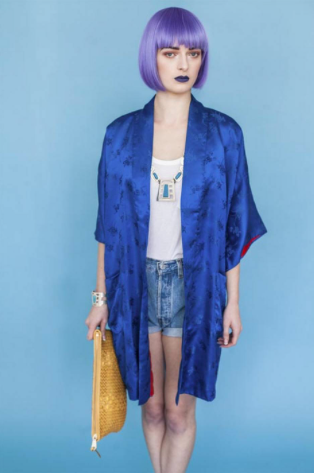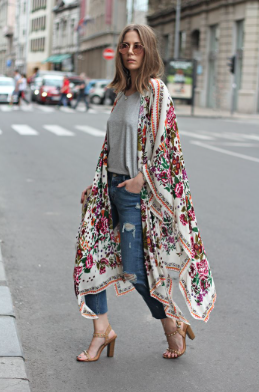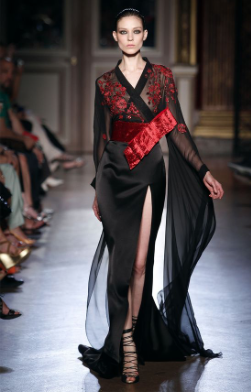Evolution of the Modern Day Kimono
- Candice Vuong
- Jun 18, 2017
- 6 min read

When you think of a kimono, what does it remind you of? Do you immediately think of an embroidered wrap style robe from Japan? Or do you think of a flowy shawl that you might buy at a discount at Forever 21 to wear with a pair of shorts in the summer? Growing up with a Chinese and Vietnamese cultural influences from my family, I have enjoyed the beauty in traditional cultural fashion. This year in my textiles class, I chose to sew a modern kimono inspired shawl as my very first sewing project. I was inspired by the Japanese culture and the influence that the country has on our fashion trends and culture.
To understand where this Japanese influence originated from, we will have to look back into the Japanese history to see how the kimono has evolved over generations.
History:
The Kimono originated at a garment inspired by the traditional Chinese Han style of clothing, only the samurai and the military rulers of Japan. At this time, there were laws prohibiting the wealthy upper class from improving their social status by living a luxurious lifestyle.

Some of the laws about kimonos from the New World Encyclopedia:
Peasants could not wear silk.
Only the grandparents of a child could give that child a dress made of cotton.
The light summer kimono could only be worn between May 15 and August 31. A lined garment was to be worn between April 1 and May 15. A padded garment was to be worn between September 9 and March 31.
The Emperor should wear ceremonial robes with large sleeves and a hakama with twelve figures represented on it. Otherwise he could wear grey and yellow when there was a pattern, and green when there was no pattern.
A retired Emperor should wear a robe of liquorice yellow, or silk dyed with a mixture of wood nut, called tsurubami.
Ministers of state should wear garments of tea color with simple patterns.
Lords and nobles of the court could wear clothes of compound colors. Officials from the fourth rank up wore tea-colored clothes; fifth rank officials wore an undergarment of red; sixth rank officials deep green; seventh rank deep blue, and the lowest rank light blue.
Now you may be thinking, why make such social distinctions between the rich and the poor? The idea was to enforce strict rules in order to maintain social order. Despite these laws, the upper class women began to buy expensive fabrics to make decorative kimonos, sparking a new era of Japanese fashion. In 1868-1921, the leaders of Japan encouraged westernization. Even the empress at the time, Empress Shōken, wore western style clothing to promote the shift in modernization. It was during this time that the Kimono's received their name. During the westernization of Japanese fashion, the kimono was then defined as a traditional Japanese garment.
Today, Kimonos have integrated into Japanese street fashion and the trend of restyling second-hand kimonos is becoming increasingly popular with the millennials. as a result of the modernization, the kimono still remains a symbol of Japanese culture and some people even wear it daily to work, to school, shopping, etc.

Structure and Design:
Something that makes a kimono unique, is the construction of the robe, simplistic pattern and the fact that none of the fabric is wasted. Laid out on a table, the fabric would be cut into 8 pieces before being sewed together in straight lines.
The wrap style and long slit sleeves, allows for ease of movement which was suitable for a culture where many activities are performed while seated on the floor. Interestingly, a kimono is worn tightly wrapped around the body from left to right because only the kimonos of the dead are wrapped right over left. The material and flow of the sleeves allows there to be ventilation and breathability during the warmer seasons.
There are some social distinctions that can be made about the woman based on the length the kimono's sleeves. Depending on the age of the girl, and marital status, the sleeves could vary in length from The size of sleeve on a kimono represented the marital status of the girls. A man knew that a girl was unmarried if her sleeves were long enough to touch the ground.
Dyes and Patterns
The dyes and designs implemented into the kimono symbolically represent a level of spirituality. Certain colours represented metaphorical and cultural meanings relating to the dye that was used to colour them. Artists that design the images on the kimonos will still take up the ancient art of painting with ink directly onto the fabric.

Some examples of the symbolism of colours include (Kimono):
Black - corresponds to water, north, Winter and wisdom.
Purple - a metaphor for undying love, the imagery deriving from the fact that gromwell, the plant used to create the dye, has very long roots.
Red - signifies youthful glamour and allure
A few examples of the symbolism of nature (5 element:fire, water, earth, wood and metal):
Flowers - (ex: cherry blossoms, peonies, chrysanthemums)
“Three Friends of Winter” - bamboo, pine and plum (perseverance and renewal)
Birds - cranes (longevity, and good fortune), dragonflies
Landscape images - mountains and streams
Instructions on how to Wear a Kimono from the New World Encyclopedia:
First, put on the white tabi socks because it will be difficult to do this later.
Put on the undergarment (juban) consisting of a white cotton top and skirt. A modern alternative is to wear only the white collar that goes around the neck (eri-sugata).
For both men and women, wrap the right side of the kimono over the body, then overlap it with the left side.
Adjust the white slip collar to show evenly around the neck just under the kimono.
Gather the kimono material up from the waist so the bottom of the kimono is at the ankle.
As you hold the extra material above your waist, tie the koshi-himo belt below the excess material. Cross the belt in the back and tie it in the front.
Straighten out the excess material to the side so that the front and the back of the kimono are smooth. Bring down the excess material to cover the belt.
Take the date-jime belt and wrap it around your waist covering the koshi-himo belt. Tie the date-jime belt in the front leaving the overlapping kimono fabric visible below. The excess kimono fabric should hang evenly below the belt so that the fabric is visible.
The traditional long obi can be very difficult to tie depending on the style of bow made. You may need another person to tie the belt for you. There are many styles of ties that can be made with the belt.
The obi-jime is the last belt tied around the obi belt.
Japanese Kimono Influence on Modern Fashion Trends:
This spring and summer, you won't be able to miss seeing a kimono inspired robe or shawl. This modern take on the kimono has become a mainstream trend. Designers have been inspired by the fabrics and elegance of the Japanese garment. The traditional kimono in mainstream fashion has become less formal and cheap to buy as they are now being made of sheer fabrics, and light polyester fabrics.
My Kimono Inspired Garment
For my kimono I was inspired my the traditional elements of simplicity, movement, and nature. To achieve the element of simplicity, chose a simple design straight as to reflect the structural concept of sewing straight lines together. in order to achieve movement, I used a light polyester fabric so that it would flow much like the Japanese kimono. The pattern on my fabric had flowers, adds inspiration from nature. My classmate Haruka is from Japan and says that she can see where my piece is inspired by the kimono but doesn't look close to a traditional
kimono. Pattern: https://www.babble.com/style/easy-handmade-kimono/
Work Cited:
"Kimono vs. Yukata – Japan Info." Japan Info. N.p., 7 Aug. 2015. Web. 18 June 2017. <http://jpninfo.com/17529>.
"V&A · Kimono." Victoria and Albert Museum. Victoria and Albert Museum, Cromwell Road, South Kensington, London. n.d. Web. 18 June 2017. <https://www.vam.ac.uk/articles/kimono>.
Victoria and Albert Museum, Digital Media Webmaster@vam.ac.uk. "A History of the Kimono." Victoria and Albert Museum, Digital Media Webmaster@vam.ac.uk. Victoria and Albert Museum, Cromwell Road, South Kensington, London. 14 Aug. 2013. Web. 18 June 2017. <http://www.vam.ac.uk/content/articles/h/a-history-of-the-kimono/>.
"Kimono." Fashion, Costume, and Culture: Clothing, Headwear, Body Decorations, and Footwear through the Ages. . Encyclopedia.com. 16 Jun. 2017 <http://www.encyclopedia.com>.
"Kimono." Kimono - New World Encyclopedia. N.p., n.d. Web. 18 June 2017. <http://www.newworldencyclopedia.org/entry/Kimono>.

















Comments